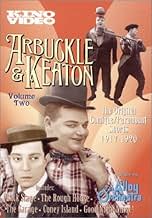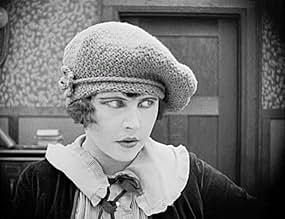Good Night Nurse
- 1918
- 26 Min.
Füge eine Handlung in deiner Sprache hinzuRoscoe's wife wants him committed to the No Hope Sanitarium for a cure from drink. He is greeted by blood spattered, cleaver-wielding Buster and a barely clad female patient. He eats a therm... Alles lesenRoscoe's wife wants him committed to the No Hope Sanitarium for a cure from drink. He is greeted by blood spattered, cleaver-wielding Buster and a barely clad female patient. He eats a thermometer and must be rushed into surgery.Roscoe's wife wants him committed to the No Hope Sanitarium for a cure from drink. He is greeted by blood spattered, cleaver-wielding Buster and a barely clad female patient. He eats a thermometer and must be rushed into surgery.
- Regie
- Drehbuch
- Hauptbesetzung
Empfohlene Bewertungen
I first saw Good Night, Nurse! as part of a Keaton retrospective at NYC's Film Forum in the early 1990s, but the print shown on that occasion was in poor condition and obviously incomplete, so much so that the story was incoherent. At one point I even wondered if the surviving pieces of the film had been spliced back together in the wrong sequence. Now that the movie has been restored from better components for its DVD release, I realize it was a bizarre piece of work to begin with, a dark comedy with a very loose plot that unfolds like a disjointed dream.
The film begins with an extended storm sequence. We find a drunken Roscoe teetering about in front of a corner drug store, trying to light a cigarette in the wind. (Watch closely as a woman with an umbrella is blown Roscoe's way by the storm -- that's Buster in drag!) When Roscoe finally makes his way home, bringing along an Italian organ-grinder, a gypsy dancer, and a trained monkey, his long-suffering wife decides that an intervention is in order, and checks Roscoe into the No Hope Sanitarium. There we meet crazed inmate Alice Lake, Al St. John in a dual role as both a doctor and a patient swathed in bandages, and most strikingly of all, young Buster Keaton as Dr. Hampton, who suavely enters the operating room in a bloody smock, sharpening a pair of steak knives. Soon Roscoe has swallowed a thermometer, provoked a frenzied pillow fight among the patients, and donned a nurse's uniform to flirt with Dr. Hampton. If you've never seen Buster smile on screen, check out the flirtation sequence here, where he matches Roscoe grin-for-grin. Eventually, Roscoe escapes from the sanitarium and everyone winds up outside, participating for a cross-country marathon race. (Again, it feels like a dream: "Then suddenly we were all outside, running a marathon," etc.) The race sequence is topped with a final surprise twist that isn't actually much of a surprise, but it wraps up the whole imbroglio on an appropriately weird, anti-climactic note. What were you expecting after all that, a real ending?
In his autobiography Buster devotes a lot of space to the elaborate practical jokes he and his good pal Roscoe Arbuckle used to cook up, when they were on top of the world and full of youthful high spirits. Good Night, Nurse! captures the flavor of those heady days as well as any movie they made together. It may not be their best comedy, but it has a wacky, prankster-like quality that's quite appealing for those willing to go along for the ride.
Firstly, at one point, Arbuckle, dressed as a nurse, flirts with Dr. Buster Keaton in a lengthy (over a minute) sequence; standing on opposite sides of a hallway, they make goo-goo eyes at each other, shyly fingering their own lips with their index fingers, and tracing sweet nothings in extreme embarrassment upon the walls near which they stand, respectively. It is interesting to see Keaton play a man smitten; his famous stone-face character of later solo films famously saw women only as necessary nuisances. More shockingly, at the end of the flirting scene, as Keaton and Arbuckle playfully push each other around, Keaton actually laughs - something we will never see him do on his own.
The funniest part of the movie is when the nearby town holds its annual "Fat Man Race". Within a minute, all the runners have fallen to the side of the road, exhausted - very funny. As can be expected, Arbuckle will accidentally fall into the race. At one point, a man paints the number "5" on a telephone pole. As expected, Arbuckle leans against the pole, and when he moves away, we see the number 5 on his back; now he really seems to be a part of the race. Bizarrely, the "5" does not appear on his back in reverse, as it should; the imprint from the pole has miraculously reversed itself!
Lastly, it may be noted that silent comedy had a penchant for sight gags that revolved around physical deformity and grotesqueness. At one point in this film, Arbuckle hands the end of a long hose to a local hick. The hick grins, showing off a vile looking orifice, filled with gum disease, but few teeth. Repulsive and pointless! Long live silent film comedy.
His wife (Alice Lake) has seen an advertisement that claims alcoholism can be cured by an operation at the "No Hope" Sanitarium (never mind that right below it is an article claiming sensationally "Seasickness Cured!"). At the entrance to the place, they meet a heavily bandaged man walking out on crutches (Joe Keaton) saying he is fully cured which gives Arbuckle pause, and allows for a little effect work when he throws the man his crutches and he catches them in perfect walking pose, done with reverse motion. When they get inside, we meet the doctor (Buster Keaton) who has blood all over his surgical gown, sharpening a giant knife as if he were going to carve up a holiday roast. We get a further glimpse of the wickedness of Arbuckle's humor when a "crazy" woman (also Alice Lake) runs into the room and throws herself into his arms. With his wife looking on, he realizes he can take advantage of the situation and after looking at the viewer, gives her a couple of kisses.
Much of the second half consists of trying to physically subdue Arbuckle to have the operation, or capture him when he tries to escape. Some of that is typical slapstick fare, like a pillow fight that results in a million feathers in the air, but there are lots of other enjoyable bits, starting with the camera gradually going out of focus when Arbuckle is sedated. At one point he disguises himself as a female nurse and then flirts awkwardly with Dr. Keaton, both men putting a finger in their mouth and bashfully looking away, Buster grinning sheepishly, a hilarious moment. Arbuckle shows once again that he was light on his feet, a result of having had dance lessons. Just watch him gracefully leap sideways into a pool to distance himself from the woman who during the escape now wants to go back, just as he pranced around so well in his living room early on. He finds himself in a race of the "200-Pound club" which amusingly has the other contestants keel over by the side of the road, and him dashing to victory.
It's certainly not politically correct today and interesting to note it wasn't politically correct in its day either, something that would eventually come back to unfairly haunt Arbuckle when he was put on trial in the Virginia Rappe case. Enjoy him here with his pal Buster, possibly at the height of his career.
The opening sequence on the street corner starts to drag a little after a while, but things pick up when Arbuckle's wife sends him to a private sanitarium, where he meets up with Keaton and Alice Lake, resulting in some weird adventures. Keaton has some very funny moments in taking advantage of Arbuckle's confusion, and the dream sequence is quite imaginative.
Most Arbuckle/Keaton fans should find more than enough here to make "Good Night, Nurse!" enjoyable. Though much of it is a little unpolished, it has plenty of humor and energy.
Wusstest du schon
- WissenswertesIncluded in "Buster Keaton: The Shorts Collection" blu-ray set, released by Kino.
- PatzerWhen Fatty rests against a freshly numbered telephone pole, the number is transferred to the back of his shirt. However, the result is an identical copy of the original whereas it should really be a mirror image.
- Zitate
Title Card: Wifey and the butler - concerned for master.
- VerbindungenReferenced in Es bleibt in der Familie: Maude (1972)
Top-Auswahl
Details
- Laufzeit26 Minuten
- Farbe
- Sound-Mix
- Seitenverhältnis
- 1.33 : 1
Zu dieser Seite beitragen




























